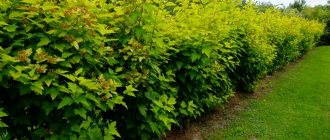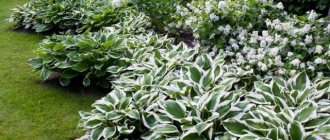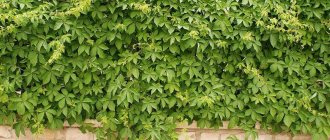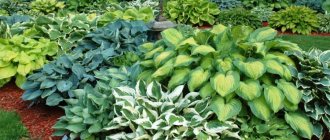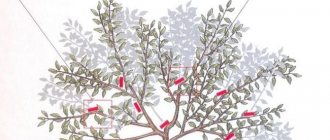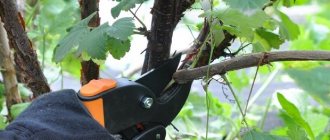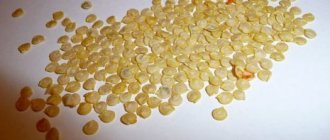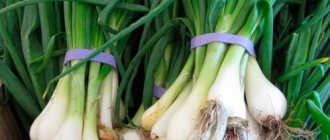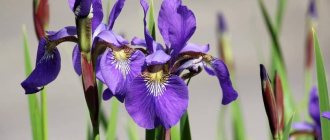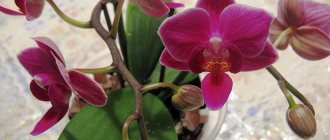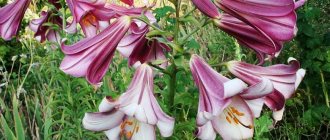A hedge is a popular option for replacing an artificial fence. It helps protect the area from prying eyes, dust, wind, pollution, and also looks great and purifies the air, saturating the area with additional oxygen.
It is important to choose the right plants that will form a natural fence. These should be shrubs or trees, unpretentious, preferably fast-growing and able to survive frosts. Thuja - great for hedges. True, among the large number of varieties of this shrub, it is necessary to find the optimal one for specific climatic conditions.
Users often search for:
- The best shrubs for hedges
- Spruce hedge
Advantages
Thuja is an evergreen tree popular for hedges. It's good because:
- improves the ecology of the site;
- unpretentious in care;
- does not respond to temperature changes and drought;
- easy to mold;
- available as shrub and tree;
- maintains a pleasant appearance all year round;
- not picky about soil, takes root almost anywhere;
- grows quickly, forming a hedge in the first year.
A thuja hedge has no disadvantages, which is why it is increasingly being chosen as a decoration for suburban areas throughout Russia.
Landing rules
Plants for fencing need to be 2–3 years old. They take root better and grow after planting. Planting is best done in the fall. During this period, the humidity is high, and the sun does not heat the air. Such conditions will have a beneficial effect on the survival rate and good rooting of seedlings.
The distance between thuja trees should be 80–120 cm. Seedlings should not be planted densely. Trees should feel comfortable. When planting in 2 rows, the distance between the rows is at least 1 m. It is better to place trees according to this pattern in a checkerboard pattern. Planting a hedge in three rows is not recommended. Due to lack of moisture, the middle row usually dies.
Did you know? Thuja has a persistent odor, so it is used in perfumery and to scent shoes.
The best varieties of thuja for hedges
All varieties of thuja can be divided into several main groups:
- dwarf plants - it is convenient to use them to form borders and small figured decorations on the site;
- bushy - the main varieties that are planted in groups to create a hedge;
- Solitaires are trees that are planted individually to create impressive barriers.
Shrubs are divided into Western and Eastern. Western varieties of thuja are optimal for the Russian climate. The choice depends not only on the climate, but also on how the fence will ultimately look. Some people want a low fence, while others want a taller fence.
Brabant
This is one of the most frost-resistant varieties. Easy to trim and grows in any type of soil. This is a fast-growing variety of thuja, so it is suitable for those who want to grow a hedge as quickly as possible. The disadvantages include a change in the color of the crown. In winter, the thuja of this variety turns red. Brabant requires a little more care compared to other varieties.
Emerald
Thuja of this variety grows more slowly and does not require frequent cutting. The crown does not change color throughout the year. This evergreen plant will maintain the appearance of the site both in summer and winter. The variety requires regular watering. He has a positive attitude towards haircuts; it is from this variety of thuja that you can make various shapes on your site.
Pyramidalis compacta
Western variety of thuja, 5-10 m tall, with a compact conical crown. At a young age, the crown of the tree is narrow, expanding with age. It loves sunny areas and grows in any soil, but fertile loam suits it best. It grows well in urban conditions and responds positively to pruning.
Columna
A tree with a crown in the form of a narrow cone up to 8 meters high. The branches are located at right angles to the trunk. The tree tolerates pruning well. It is a fast-growing species of thuja and forms a hedge in the first year. Columna easily tolerates frosts in middle areas and takes root well in urban environments.
Spiralis
It got its name due to its spiral-shaped crown. The plant gets this appearance due to its shoots, which twist around their axis as they grow. If the tree lives in comfortable conditions, then the growth per year can be 30 cm.
Recommended reading:
- Living willow fence
- Living fence made of climbing plants
HISTORY OF TUARY DISTRIBUTION
The homeland of thuja is considered to be North America and East Asia. Plants from these two continental parts are very different from each other and therefore they were divided into two main types - thuja occidentalis and thuja eastern.
For gardeners, the greatest interest is the thuja occidentalis or the “tree of life”, as it is also called. Thuja occidentalis was brought to Europe from the northeastern regions of North America in the middle of the 15th century.
In Russia, it began to be actively used in the design of palace parks and landscaping of large cities from the end of the 16th century.
Unlike the eastern thuja, the western one is more compact and does not exceed 3.5 m in height. The most beautiful are the thujas with a golden crown.
Today, the most fashionable variety of such thuja is considered Yantar , which in the last three years has repeatedly become the winner of International and All-Russian competitions and exhibitions.
How to choose seedlings
To make the hedge beautiful, you need to buy seedlings from specialized nurseries. This is a guarantee of the authenticity of the variety. Plants must be in the containers in which they grew. On the market, seedlings are often sold with bare roots. If the roots break off, it is better to refuse the purchase.
Young seedlings are easy to identify by their crown. It should be bright green in color with no signs of lethargy or dryness.
You should not buy an expensive, mature tree - it may not take root. Seedlings take root best in a pot or with a ball of earth.
Description of culture
There are 5 types of thuja, of which the western one has become widespread in Russia, as the most winter-hardy, unpretentious, elegant and original plant.
Characteristics of the variety
Western thuja Columna (Thuja occidentalis Columna) belongs to the group of columnar varieties with an average growth rate: per year the thuja increases in height by 15-20 cm, in width by 5-7 cm.
The maximum height is 10 m in a single planting and 8-9 m in group plantings. The plant forms a tall narrow column with a diameter of no more than 1.5 m.
Appearance
The crown is smooth, dark green, consists of horizontal short skeletal branches, the ends of which end in fan-shaped overgrown shoots with soft shiny needles. As the temperature drops, it turns bronze, and in spring the color changes to green.
Due to its structural features, the surface of Columna looks like a homogeneous dense mass.
The bark is rough, red-brown. The root system is superficial, fibrous. The variety is frost-resistant, unpretentious, suitable for forming green walls and hedges that do not require cutting.
DIY thuja fence
To create a full-fledged hedge yourself, you need to carefully approach all stages of planting, from choosing a location to calculating the distance between plants. You also need to prepare the soil for planting, and then follow the rules of care and regularly trim the thuja to give it the required shape.
Choosing a landing site
The planting site should be away from groundwater and preferably in the sun. Thuja loves excess moisture and at the same time grows well in the sun. In the shade, the plant develops worse, and the crown looks less attractive. If the soil is heavy, then a drainage layer 15 cm thick will need to be laid at the bottom of the planting hole. Thuja can be planted in autumn and spring.
Optimal distance between plants
When planting seedlings, it is important to maintain a certain distance so that in the future the trees do not interfere with each other’s growth and the hedge is formed without problems. It depends on the characteristics of a particular variety. Large ones require a lot of space, and therefore the best distance for them is 1-2 meters. When planting along a fence, the distance between seedlings can be reduced to 70 cm.
Soil preparation
For active growth, it is necessary to properly prepare the soil mixture. There are 3 options for soil mixtures for planting thuja hedges:
- Fertile soil from the site, mixed with sand and peat in a ratio of 2:1.
- Leaf humus, sand, peat, compost in a ratio of 2:2:1:3.
- Soil from the forest, sand, soil from the garden 3:1:2, plus 100 grams of nitroammophoska.
The hole for planting low-growing thuja should be 40 cm wide and 50 cm deep. For large trees, a convenient size is 60x100 cm. For clay soils, drainage is required. It is formed from small stones, expanded clay or crushed stone, which is poured onto the bottom of the planting pit. Then sand is poured and only then fertile soil.
Landing
Before planting, the thuja seedling must be placed in a bucket of water for 1-2 hours. After this, the seedling can be moved to the planting hole. It is important that the earthen lump is not destroyed. The lower part and sides of the roots should be slightly torn so that the roots are distributed over the entire area of the planting hole.
The trunk must be placed strictly vertically. If this is done with even a slight slope, then the thuja itself will also grow with a slope and will spoil the appearance of the hedge. With proper planting, the root collar should be flush with the ground level, and the buds should be 2-5 cm higher. After planting, you need to fill the hole and water it in 2-3 steps. It is recommended to add a growth stimulator to the water for irrigation. This will allow the seedling to grow more actively.
If you mulch the ground around the thuja, you can avoid moisture evaporation and protect the soil around the seedling from overheating. You can use wood chips, peat, bark or paper as mulch.
Planting scheme
There are several schemes, each of which depends on the selected variety and what kind of hedge you want to see. Large trees are planted along a stretched control rope. It will mark the line along which the holes will be dug.
For dwarf varieties, instead of holes, dig a trench. When the distance between seedlings is 2 meters, you need not just pull the rope, but drive pegs into the ground. Then the line will be smoother.
To grow a dense hedge, a two-row checkerboard planting pattern is often used. Since thuja does not like shade and does not develop well in the absence of light, it is not recommended to plant it in three rows - the middle one will develop slowly.
Thuja care
Like any cultivated plant, thuja needs care. Despite its unpretentiousness, this tree requires watering, fertilizing and protection from pests and diseases, especially in the first year.
In summer, it is recommended to protect the tree from the scorching rays of the sun. When watering, you should focus on soil moisture. It is worth watering thuja about once a week at the rate of 1 bucket of water per 1 adult plant. In summer, it’s a good idea to spray the crown additionally. You can cancel spraying 2 months after planting.
When planting, the plant will need mineral fertilizing. It will last for several years, and then you need to regularly feed the thuja in the spring with complex fertilizers. There are fertilizers developed specifically for this shrub.
Thuja is a frost-resistant plant, but the first winter can be disastrous for the seedlings. Therefore, in late autumn, young seedlings should be covered with warm specialized material. It must retain heat and at the same time block the sun, which is no less dangerous in winter than in summer and can burn the crown of a young tree.
The gardener should regularly inspect the plant for diseases and pest damage. At the first symptoms, the entire hedge should be sprayed.
The root system of a young tree should also be insulated before frost, since young roots are susceptible to freezing. Foliage from the site mixed with soil works well as insulation. If you throw it around the plantings, the roots of the thuja will completely survive the frosts of central Russia. Insulation will also serve as additional fertilizer for young plantings. It is necessary to insulate seedlings for up to three years. Mature trees will easily survive frosty winters without additional care.
Arborvitae haircut
To maintain a healthy hedge, it is recommended to trim it regularly. It is important to carry out not only formative pruning, but also sanitary pruning.
Timely and competent pruning will allow the bush to remain healthy and develop in the right direction. The specific timing of cutting depends on the variety. It is recommended to check these periods with the nursery when purchasing a seedling. It is better to cut off excess branches in the spring. When pruning, which began before the formation of buds, the growth of branches may stop. For all trees and varieties of thuja, there is a general pruning rule - you cannot remove more than a third of the total crown volume. Otherwise, the seedling will dry out and it will be impossible to restore it.
When forming the crown, it is important that the branches expand downward. For cutting, pruning shears or garden shears are sufficient. When growing thuja in a small amount, mechanical garden shears will be quite sufficient to form a hedge. It is important that scissors and all other garden tools are sharpened.
Green wall care
Pruning gooseberries in spring, summer and autumn
Despite the fact that thuja is quite unpretentious, it still requires care. Particular attention should be paid to young plants; there are some nuances here.
Green wall
After planting, young seedlings require watering at least once a week, and twice in extreme heat. One shrub requires about 10 liters of water; during periods of drought, the watering rate should be doubled. After watering, loosening is mandatory, but not deep. The root system of the thuja is very superficial, and there is a great danger of damaging the fragile roots. The soil must be cultivated to a depth of no more than 10 cm.
Note! It would not be a bad idea to mulch young plantings. This will retain moisture in the soil and prevent the formation of crusts and cracks. Peat or wood chips are perfect as mulch.
Young thuja seedlings are not as frost-resistant as older plants. During the first two years of growth, seedlings should be protected from winter frosts and bright spring sun. To do this, you can use white non-woven material, kraft paper or spruce branches.
It is better to add fertilizer to the soil before planting, in which case the seedlings will not require additional feeding during the first year. In addition, thuja does not tolerate excess mineral fertilizers. Only from the second year should you resort to mineral or organic fertilizers.
Photo gallery: living thuja fence in landscape design
A thuja fence is an excellent option for a hedge made of an evergreen shrub with a pyramidal crown. It is easy to care for, does not require much watering, and has a green crown all year round - this is only a small part of the advantages of this plant. There are several varieties to choose from, varying in height and care requirements.
To get a good hedge, you just need to choose a suitable variety, think through the planting scheme and care for the young seedlings. In a couple of years they will get stronger and turn into a full-fledged living fence with minimal maintenance requirements.
How to cut thuja: tools
It is not enough to know how to trim thujas; you should also pay attention to choosing the right tool.
Tools
The pruning tool should be selected depending on the thickness of the plant branches. This could be a pruner, garden shears or a hedge trimmer. To trim a thuja, as a rule, pruning shears and garden shears are enough.
The main point when preparing a pruning tool is sharpening it. It should be sharp to avoid creases on the branches. It is also recommended that during the cutting process, wipe the blade of the tool with resin and cut branches to remove dirt from it.
If the thuja needles have turned yellow
This symptom always worries gardeners. What to do to stop the process and return the thuja to its former rich color?
Possible reasons for this problem:
- Domestic animals have chosen a place under the trees to relieve their “minor needs” there. Their urine burns the needles, causing excess alkali to appear in the plant. The way out of the situation is to find a way to limit animals' access to trees.
- Burning of needles by the rays of the spring sun, when the soil has not yet had time to warm up and the roots have not “woke up”. This means you will need shelter.
- A slight yellowing of the thuja may also indicate its preparation for winter. There is no reason to worry.
